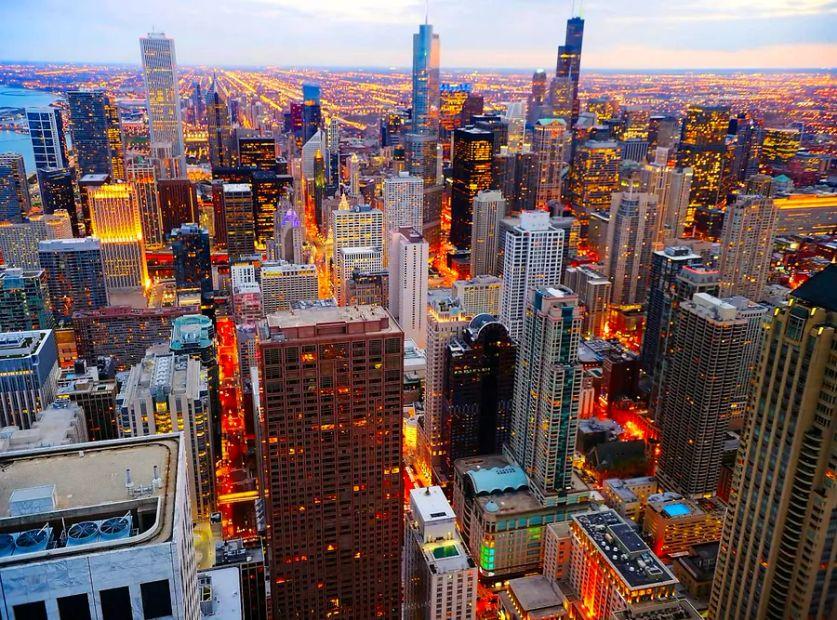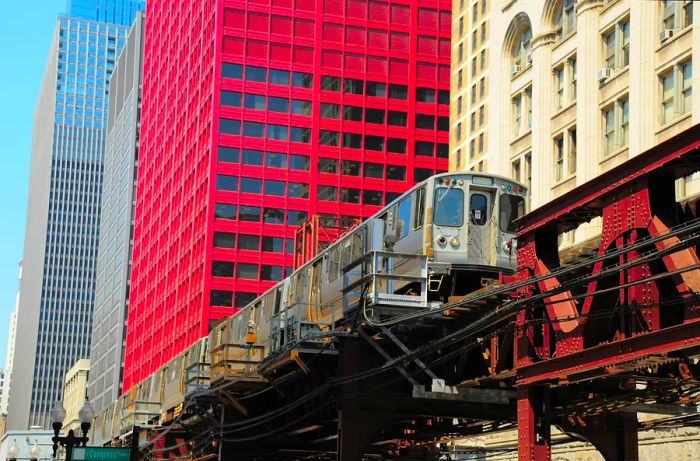Top Ways to Navigate Chicago

As the third-largest city in the US, Chicago boasts an efficient public transportation system, making exploration a breeze for travelers. This accessibility means that you can easily reach Chicago's must-see attractions, whether you're relaxing by the iconic 'Bean' in Millennium Park, catching a game at Wrigley Field, or enjoying live music at famous spots like Buddy Guy's Legends, all thanks to Ventra, the city's handy travel pass.
The L, a network of elevated trains and subways, serves as the primary mode of transport in the Windy City, while buses offer additional routes through downtown and suburban areas. Here are the best travel options around Chicago.
 The L connects various neighborhoods across Chicago, linking the northern suburbs to the towering skyscrapers of the Loop. Getty Images
The L connects various neighborhoods across Chicago, linking the northern suburbs to the towering skyscrapers of the Loop. Getty ImagesUse the L train for seamless travel around the city
The L, short for 'elevated,' is a quick and frequent mode of transport that takes you to most attractions and neighborhoods in Chicago. With trains operating to various parts of the city, two of the eight color-coded lines—the Blue Line to O'Hare Airport and the Red Line—run 24 hours a day. Other lines operate from about 4am to 1am daily, with trains departing approximately every 10 minutes.
Trains predominantly run on elevated tracks in suburban areas, transitioning underground in the downtown Loop. The regular fare is $2.50 (around $5 for rides from O'Hare Airport). Transfers are free within 2 hours, allowing for up to two additional rides. Use a Ventra card to pay for your trips, available at train stations and drugstores.
Metra trains offer solid links to suburban areas
In addition to the L, Metra commuter trains operate 12 routes connecting the Chicago suburbs from four terminals around the Loop: LaSalle Street Station, Millennium Station, Union Station, and Richard B. Ogilvie Transportation Center. Some Metra lines run daily, while others are limited to weekday rush hours. Tickets can be purchased from agents or machines at major stations.
Buses fill in the gaps in Chicago's transit system
Chicago's buses serve areas not covered by the L trains, with many routes following straight paths along major thoroughfares, simplifying navigation. Most buses operate from early morning until 10pm, with some running later and others not available on weekends. The standard fare is $2.25, and transfers within two hours are complimentary (allowing for up to two additional rides). Payment can be made with a Ventra card or exact change to the driver. Buses are especially handy for reaching Hyde Park, Lincoln Park Zoo, and the cultural sites within the Museum Campus (including the Art Institute of Chicago).
Use Chicago's trackers and apps to plan your routes
For maps and route planning, visit the Chicago Transit Authority's website. The CTA Train Tracker and CTA Bus Tracker provide real-time arrival updates. Navigation apps like Google Maps and CityMapper are also beneficial. Additionally, you can download the Ventra app, which features a trip planning tool.
Get a Ventra card to save on all-day travel
The Ventra card serves as Chicago's rechargeable public transit pass. It requires a one-time fee of $5, which is refunded upon card registration. Using a Ventra card saves approximately $0.75 on each bus and train fare. You can buy Ventra cards at train stations and pharmacies. Unlimited ride passes are also available, costing $5 for one day, $15 for three days, or $20 for a week.
 Chicago features numerous dedicated paths for cyclists. pawel.gaul/Getty Images
Chicago features numerous dedicated paths for cyclists. pawel.gaul/Getty ImagesRent a bike to discover Chicago on two wheels
With over 300 miles of bike paths, Chicago is becoming one of the top large cities in the U.S. for cycling. Recently, 200 miles of protected, buffered, and shared bike lanes have been added, with more planned. A popular route is the 18.5-mile Lakefront Trail, which follows Lake Michigan, showcasing the city's scenic beaches and harbors. Bicycles can be taken on L trains free of charge, except during peak hours (7am to 9am and 4pm to 6pm, Monday through Friday). Most buses have front bike racks that hold two bikes at a time.
With the popular bike-share program Divvy, you won’t need to stress about bringing your bike on the L or bus—there are around 600 stations scattered throughout Chicago and nearby suburbs. An $18.50 day pass grants unlimited rides for up to three hours each within a 24-hour timeframe, or you can choose a single-ride pass. Passes can be purchased at station kiosks or through the Divvy app. Be aware that charges can escalate quickly if you fail to dock your bike on time. The Divvy app simplifies the process of locating docks, checking availability, and making payments.
For longer rides, bike rentals start at approximately $8 per hour, including accessories like helmets and locks. Consider Bike & Roll, which has locations near Millennium Park and Navy Pier, or Bobby's Bike Hike, where you can find discounts for online bookings.
Boats provide convenient transfers along the lakeshore
Water taxis offer an enjoyable alternative to walking or taking the bus. These boats navigate along the Chicago River and the lakefront, providing a unique way to access the Museum Campus.
Shoreline Water Taxi connects several major tourist attractions, operating various routes from April to October. The Lake Route takes you from Navy Pier to the South Loop's Shedd Aquarium, while the River Taxi links Polk Bros Park (just west of Navy Pier) to Willis Tower via the southeast side of the Adams Street Bridge.
Ticket prices vary depending on the day of travel, with a one-way adult fare ranging from $10 to $21 (children pay half). Weekends are particularly busy travel times. Additionally, a Commuter Taxi operates from the Michigan Avenue Bridge (northeast side, near the Tribune Tower) to Willis Tower/Union Station.
Driving in Chicago is less than ideal
Navigating Chicago by car can be frustrating. Traffic jams occur not only during peak morning and evening hours but also throughout the day. For short trips, it's advisable to opt for public transport instead of dealing with the stress of driving.
If you choose to rent a car for day trips or outings to the suburbs, you'll find major car rental agencies readily available in Chicago. Prices can vary significantly; generally, renting at the airport is more costly than downtown. You usually need to be at least 25 years old, possess a valid driver's license, and have a major credit card to rent a vehicle.
The car-sharing service Zipcar is quite popular in Chicago. Rates start at $11 per hour or $83 per day, which includes gas, insurance, and convenient parking spots throughout the city. Membership is required, which comes with a monthly or annual fee, plus an application charge.
 Ride-hailing apps often provide lower fares compared to traditional taxis. Conchi Martinez/Shutterstock
Ride-hailing apps often provide lower fares compared to traditional taxis. Conchi Martinez/ShutterstockTaxis are easily accessible, but ride-hailing options can save you money.
Licensed taxis are abundant in the Loop and extend north to Andersonville and northwest to Wicker Park and Bucktown. You can hail one from the street simply by raising your hand. Fares are metered, starting at $3.25 upon entering the cab, then $2.25 per mile thereafter.
The first additional passenger incurs a $1 fee, while each extra passenger after that costs $0.50. Don’t forget to tip 10% to 15% on top of your fare. All major Chicago taxi companies accept credit cards; reliable choices include Checker Taxi and Flash Cab.
Ride-hailing services like Uber, Lyft, and Via are quite popular in Chicago and may offer lower rates than traditional taxis.
Transportation options for accessibility in Chicago
Most major attractions and museums in Chicago are wheelchair accessible, along with many large hotels and dining establishments. All city buses support wheelchair access, although roughly one-third of L stations lack this feature. Easy Access Chicago is a complimentary resource that details museums, tours, restaurants, and accommodations, including accessibility information for mobility, vision, and hearing.
For inquiries about available services in the city, you can contact the Mayor's Office for People with Disabilities.

1

2

3

4

5
Evaluation :
5/5